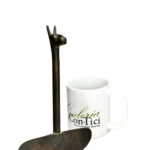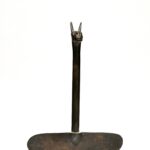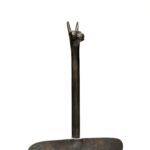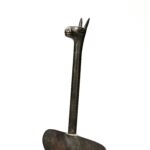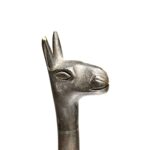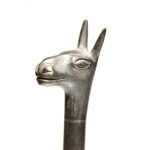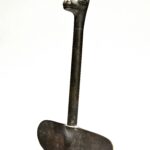Inca Tumi, Peru, ca. 1400-1500 AD – Copper Knife, Llama
Intricate Details and Artistic Narrative of this
Inca Copper Tumi
This Inca copper tumi ceremonial knife from Peru dates back to the Late Horizon period, ca. 1400 – 1500 AD, a peak era for the Inca Empire’s artistic and ritual advancements. Expertly crafted, this pre-Columbian artifact stands 8.75 inches (22.2 cm) tall with a striking 6-inch (15.2 cm) wide blade, highlighting the skilled metalwork of ancient Andean artisans. Topped with a finely detailed llama head, the Inca tumi holds cultural significance, as llamas were essential to the Inca Empire for transport, wool, and ritual. The animal’s expressive face embodies the Inca’s symbolic reverence for llamas. The copper has a rich, natural brown patina.
Adding to its uniqueness, this tumi includes an inlaid band of alloy placed three-quarters up the shaft, just below the llama’s head. This rare and unexplained feature is considered to be an Inca innovation (Bray 1990, p. 310) that showcases an advanced and lesser-known Inca metalworking technique that adds both mystery and significance to the artifact.
Traditionally reserved for sacrificial and essential ceremonies, the tumi symbolizes Inca beliefs and advanced metallurgy. This particular tumi’s llama finial reflects the cultural heritage of the Inca, who viewed llamas as sacred symbols of prosperity and fertility within Andean cosmology. The Inca’s reverence for the llama, alongside their skill in metalworking, is captured in the animal’s expressive face.
The tumi’s semi-circular blade is thought to echo the shape of the sun, potentially linking the knife to Inti, the Inca Sun God, a revered figure symbolizing divine energy. This shape would have imbued the knife with additional symbolic power in Inca rituals.
The Inca Empire demonstrated highly advanced metallurgical skills, especially in copperwork, during this period. This artifact exemplifies the sophisticated techniques of ancient Andean metalworkers, including smelting, hammering, and detailed finishing. Such craftsmanship reflects the elevated status of metalworkers in Inca society and the ceremonial importance of items like the tumi.
Condition: Choice, with a well-preserved patina that attests to its authenticity and age.
Provenance: Ex-Private Florida collection; previously held by S. Handbury-Madin in the UK.
Price: $2,850 – Domestic Delivery Included
This item may become featured here in the Native American Art Magazine
Click here to see our next item.
Are you seeking a particular piece? Please feel free to let us know.
Regional Division of Pre-Columbian Americas’ Major Archaeological Cultural Phases


